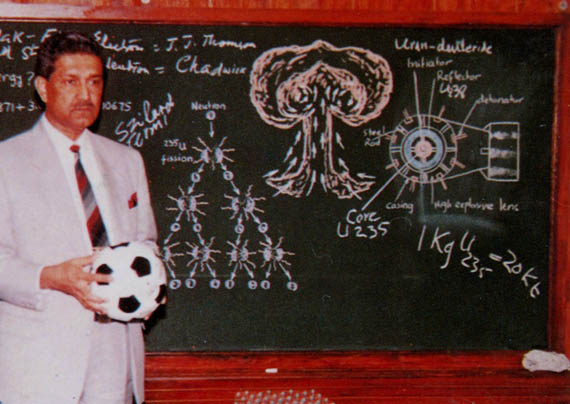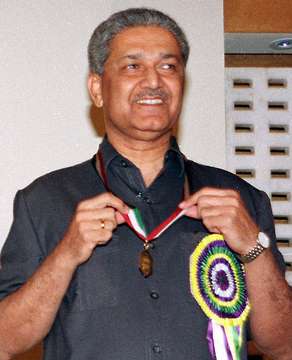
Aqil Khan
The need for Pakistan to develop a
nuclear deterrent to meet India's nuclear capacity.
After India's nuclear test — code name “ Smiling Buddha” in May 1974,Prime
Minister Zulfiqar Ali Bhutto sensed and saw this test as final anticipation for
Pakistan’s death. In a press conference,
held shortly after India's nuclear test, Bhutto said, "India's nuclear
program is designed to intimidate Pakistan and establish "hegemony in
the subcontinent”.
Despite Pakistan’s limited financial
resources, Bhutto was so enthusiastic about Pakistan’s nuclear energy project,
that he is reported to have said
"Pakistanis
will eat grass but make a nuclear bomb”.
During the early stage of Pakistan's
nuclear weapons program, the Pakistan Atomic Energy Commission proposed to develop
the plutonium-based nuclear weapons for which few
bureaucrats/ officials advised Mr. Bhutto
to buy a Nuclear reprocessing plant which later proved to be
misleading because of following main reasons:
Ø No
fuel was available for reprocessing at that time as only a 135 MW KANUPP
commercial nuclear reactor commissioned
in 1972 was quite insufficient to produce/generate required amount of fuel to be reprocessed for plutonium based programme.
Ø Pakistan
was not economically/technologically in
a position to invest and build more reactors indigenously to produce fuel for reprocessing and to develop the lengthy and expensive infrastructure at that time.
Ø
Like KANUPP, if more reactors were built , would had been under the
supervision of International atomic energy
agency and it was not possible to get the fuel from there for reprocessing.
Ø After
18 years of efforts with the
help of Chinese, Khushab Plutonium project (KCP-I), only a
50 MWe pressurized heavy water reactor (PHWR) near Khushab, was built,
Known as Khushab-I,
it went critical and started its operations in April 1998. Pakistan
detonated five nuclear devices in the Chagai on 28 May 1998 and till
that time Pakistan was having only enriched Uranium from KRL for detonation.
Late
Mulana Kausar Nyazi of PPP mentioned in
his book that the then bureaucrats/ officials had misled Mr. Bhutto and he
sought on a long journey to try to get Nuclear fuel reprocessing plant from
France.
After knowing huge investment,
nonavailability of infrastucture, lengthy procedure and internatoinal restrictions
for achieving plutonium base project, Mr Bhutto called Dr.Abdul Qadeer Khan
from Holand.
A.Q.Khan after finishing his college in
Karachi ,went to Europe in 1961 to continue his studies. First in Germany he
attended the Technische Universität of West Berlin, then in Holland where he
received a degree in metallurgical engineering at the Technical University of
Delft in 1967. Finally Dr Abdul Qadeer Khan received a Ph.D. in metallurgy from
the Catholic University of Leuven in Belgium in 1972. After Ph.D., A.Q. Khan
went to work for the Physical Dynamics Research Laboratory (FDO), a subsidiary
of Verenigde Machine-Fabrieken, in Amsterdam Holland in May 1972. FDO was a
subcontractor to Ultra-Centrifuge Nederland (UCN)
- the Dutch partner of the tri-national European uranium enrichment centrifuge
consortium URENCO, made up of Britain, Germany, and the Netherlands.
In
spring of 1976,Kahuta Reserch Facility, then known as Engineering Research Laboratories (ERL),
was established by Prime Minister Z,A. Bhutto as part of codename Project-706. The program was separated from the Pakistan Atomic Energy
Commission (PAEC) and was brought under nuclear scientist Dr. Abdul Qadeer Khan and the Pakistan Army Corps of Engineer’s Lieutenant-General Zahid Ali Akbar. Dr. A.Q. Khan was to report directly to the
prime minister Z. A. Bhutto.
Bhutto
sought an advantage in establishing another comparatively low-cost parallel programme, the uranium enrichment
base programme under Dr Abdul Qadeer Khan.
Centrifuge Enrichment Process:
Several methods now exist to enrich uranium.
Pakistan’s nuclear weapons program is primarily based on enriched uranium
produced with centrifuges. Without going into technological details of tiny
steel ball bearings used in centrifuges, metal membranes, and steel springs
used to dampen centrifuges, here we briefly discuss the process led by Dr.
Abdul Qadeer Khan of high speed gas centrifuges, devices that spin at very high
speeds for extended period of time. First the Uranium is combined with the
fluorine to produce uranium hexafluoride gas UF6. Then the centrifuge is filled
with the gas and spun very rapidly. The molecules of 238UF6 are slightly heavier tend to concentrate in the outer areas of
cylinder, leaving the slightly lighter molecules 235UF6 near the center of centrifuge. Gas is
extracted from the region where the molecules of 235UF6 concentrate and feed to the next
centrifuge.This procedure is repeated again and again, a few thousand times,
depending upon the desired level of enrichment.
Prime Minister Zulfiqar Ali Bhutto mentioned
that: "No less than any other nation did what Dr.Abdul Qadeer Khan is
doing; the Soviets and Chinese; the British and the French; the Indians and the
Israelis; stole the nuclear weapons designs previously in the past and no one
them but rather tend to be quiet”.
According to Dr. Abdul Qadeer Khan in an
interview, the first low enrichment was
done at Kahuta on 6th April 1978.
The plant was made operational in 1979
and by 1981 was producing
substantial quantities of enriched uranium and A.Q.Khan sent a memo on the successful enrichment to Ghulam Ishaq Khan( the then Pakistan
Minister of Finance).
In recognition of A. Q. Khan's contributions the ERL was renamed the A.Q. Khan Research Laboratories (KRL) by President Zia ul-Haq on 1st May 1981.
In recognition of A. Q. Khan's contributions the ERL was renamed the A.Q. Khan Research Laboratories (KRL) by President Zia ul-Haq on 1st May 1981.
The underground iron-steel tunnels having
been long constructed by Provincial Martial Law Administrator Lt.General
Rahimuddin Khan during the 1980s for
nuclear tests in Chagai Blochistan.
Role of General Zia ul haq in Pakistan's nuclear
program.
http://www.youtube.com/watch?v=TpYUQV-lIxk&feature=shareDr.A.Q.Khan with President of Pakistan Farooque Laghari and Prime Minister Benazir Bhutto.

After the Indian nuclear weapons tests in May1998, Abdul Qadeer Khan repeatedly met with Prime Minister Nawaz Sharif, asking for permission to test the atomic bomb in Chagai.
Finally, on 28 May 1998, a few weeks after India's second nuclear test (Operation Shakti), Pakistan detonated five nuclear devices in the Chagai Hills, Balochistan.
Dr. Abdul
Qadeer Khan displaying his Gold Medal awarded by President of Pakistan Rafiq
Tarrar in Lahore after the 1998 tests.
http://www.youtube.com/watch?v=n7IELEGf6NI&feature=share
Pakistan nuclear weapons program was developed to stop India
from launching a war like 1971 and no one can disagree that presence of nuclear
weapons have achieved that objective in last three decades and helped nation to
maintain peace with honor in South Asia.
Tribute to Dr. Abdul Qadeer Khan Mohsin-e-Pakistan.
http://www.youtube.com/watch?v=BPrZoE6j5OY&feature=related












No comments:
Post a Comment
Note: Only a member of this blog may post a comment.